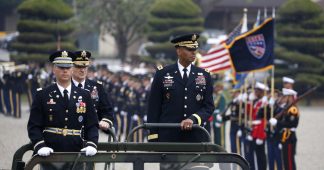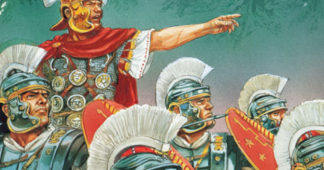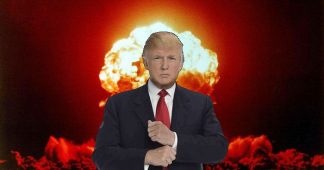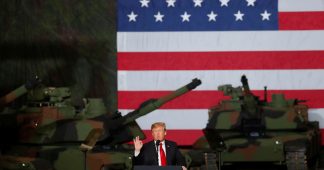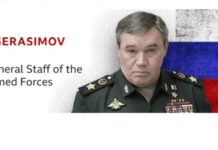The commander in chief is impulsive, disdains expertise, and gets his intelligence briefings from Fox News. What does this mean for those on the front lines?
by Mark Bowden
November 2019
For most of the past two decades, American troops have been deployed all over the world—to about 150 countries. During that time, hundreds of thousands of young men and women have experienced combat, and a generation of officers have come of age dealing with the practical realities of war. They possess a deep well of knowledge and experience. For the past three years, these highly trained professionals have been commanded by Donald Trump.
Amid threats spanning the globe, from nuclear proliferation to mined tankers in the Persian Gulf to terrorist attacks and cyberwarfare, those in command positions monitor the president’s Twitter feed like field officers scanning the horizon for enemy troop movements. A new front line in national defense has become the White House Situation Room, where the military struggles to accommodate a commander in chief who is both ignorant and capricious. In May, after months of threatening Iran, Trump ordered the carrier group led by the USS Abraham Lincoln to shift from the Mediterranean Sea to the Persian Gulf. On June 20, after an American drone was downed there, he ordered a retaliatory attack—and then called it off minutes before it was to be launched. The next day he said he was “not looking for war” and wanted to talk with Iran’s leaders, while also promising them “obliteration like you’ve never seen before” if they crossed him. He threatened North Korea with “fire and fury” and dispatched a three-aircraft-carrier flotilla to waters off the Korean peninsula—then he pivoted to friendly summits with Kim Jong Un, with whom he announced he was “in love”; canceled long-standing U.S. military exercises with South Korea; and dangled the possibility of withdrawing American forces from the country altogether. While the lovefest continues for the cameras, the U.S. has quietly uncanceled the canceled military exercises, and dropped any mention of a troop withdrawal.
The generals I spoke with didn’t agree on everything, but they shared the following five characterizations of Trump’s military leadership.
I. HE DISDAINS EXPERTISE
Trump has little interest in the details of policy. He makes up his mind about a thing, and those who disagree with him—even those with manifestly more knowledge and experience—are stupid, or slow, or crazy.
As a personal quality, this can be trying; in a president, it is dangerous. Trump rejects the careful process of decision making that has long guided commanders in chief. Disdain for process might be the defining trait of his leadership. Of course, no process can guarantee good decisions—history makes that clear—but eschewing the tools available to a president is choosing ignorance. What Trump’s supporters call “the deep state” is, in the world of national security—hardly a bastion of progressive politics—a vast reservoir of knowledge and global experience that presidents ignore at their peril. The generals spoke nostalgically of the process followed by previous presidents, who solicited advice from field commanders, foreign-service and intelligence officers, and in some cases key allies before reaching decisions about military action. As different as George W. Bush and Barack Obama were in temperament and policy preferences, one general told me, they were remarkably alike in the Situation Room: Both presidents asked hard questions, wanted prevailing views challenged, insisted on a variety of options to consider, and weighed potential outcomes against broader goals. Trump doesn’t do any of that. Despite commanding the most sophisticated intelligence-gathering apparatus in the world, this president prefers to be briefed by Fox News, and then arrives at decisions without input from others.
“We have defeated ISIS in Syria, my only reason for being there during the Trump presidency,” he tweeted. Later that day he said, “Our boys, our young women, our men, they are all coming back, and they are coming back now.”
This satisfied one of Trump’s campaign promises, and it appealed to the isolationist convictions of his core supporters. Forget the experts, forget the chain of command—they were the people who, after all, had kept American forces engaged in that part of the world for 15 bloody years without noticeably improving things. Enough was enough.
At that moment, however, American troops were in the final stages of crushing the Islamic State, which, contrary to Trump’s assertion, was collapsing but had not yet been defeated. Its brutal caliphate, which had briefly stretched from eastern Iraq to western Syria, had been painstakingly dismantled over the previous five years by an American-led global coalition, which was close to finishing the job. Now they were to stop and come home?
Here, several of the generals felt, was a textbook example of ill-informed decision making. The downsides of a withdrawal were obvious: It would create a power vacuum that would effectively cede the fractured Syrian state to Russia and Iran; it would abandon America’s local allies to an uncertain fate; and it would encourage a diminished ISIS to keep fighting. The decision—which prompted the immediate resignations of the secretary of defense, General James Mattis, and the U.S. special envoy to the mission, Brett McGurk—blindsided not only Congress and America’s allies but the person charged with actually waging the war, General Joseph Votel, the commander of U.S. Central Command. He had not been consulted.
Read more at https://www.theatlantic.com/magazine/archive/2019/11/military-officers-trump/598360/
